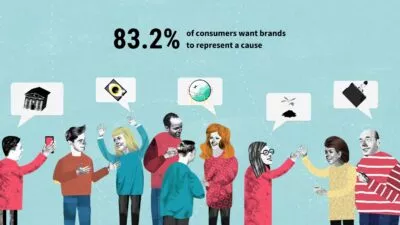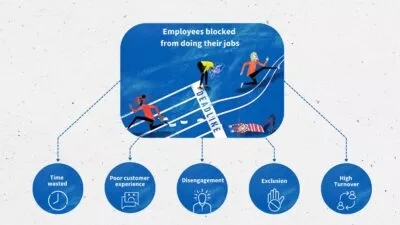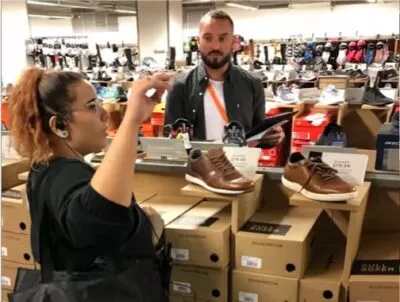17 May 2023
Staying ahead of the retail curve
A look at recent consumer trends in retail, with insights into what brands can do to keep up with the changing demands of the market.
-
Anna Boscoe
User Experience Content Specialist
Anna Boscoe
Reading time: 5 – 7 minutes
It’s no secret that the only true constant in commerce is change. Although change may seem daunting, it also presents an opportunity for growth and development. By embracing new ideas and strategies, companies can stay ahead of the retail curve and position themselves for success.
Enhancing the customer experience
Over the next few years, it’s predicted that the retail industry will experience ‘sluggish’ growth. This is due to a variety of factors, such as the negative impact of the pandemic and current economic uncertainties.
According to a global survey of commerce trends in 2023 by Shopify Plus, rising costs are the key concern of consumers, with many brands no longer enjoying the same level of brand loyalty. If this expected decrease in spending power continues, consumers will undoubtedly seek out better and more sustainable deals.
Consumers today expect a personalised, immediate, and responsive shopping experience, no matter where they are. To meet this expectation, global businesses are prioritising customer experience as their top priority, knowing that this not only increases revenue but also ensures overall customer satisfaction.
Walk the talk on values and ethics
The price of products and services are not consumers’ only concern. They also care about the ethical practices of the businesses they support.
A recent survey conducted by Attest revealed that 83.2% of UK consumers want brands to represent a cause: 45% want brands to address poverty and inequality, while over 41% want brands to address climate change. Gen Z (those aged 11-26), in particular, are significantly more likely to want brands to take action on racism (47.2%).
With this growing trend of consumers seeking to support more ethical businesses, prioritising ethical practices is not only a matter of conscience but also crucial for brand success.

Telling your story
Being ethical is one challenge but telling that story to your customers in a useful way is another.
Anyone familiar with ESG (Environmental Social Governance) investing might recognise the problem here. It’s challenging to understand whether a company is genuinely acting responsibly.
Firstly, information about their practices, emissions and more is incomplete and inconsistent. Secondly, ESG ratings (AAA, AA etc.) can be complex and confusing.
For example, Tesla – a company you would think of as doing well environmentally – doesn’t actually have a great rating because of other risks that aren’t immediately obvious.
If this is confusing for investors, then the busy consumer will also face the same challenge. How do you know if a company is really ethical? Are they succeeding in one area but damaging in another? Do they have a clear path to doing better? Or is it all just greenwashing?
Looking to the future, perhaps there will be readily available standardised rating systems for retailers based on consistent, accurate disclosures. But for now, brands may well have to rely on consciously truthful storytelling and, more importantly, trust.
Patagonia is a prime example of a brand that has earned consumer trust by sharing stories about their working practices and being transparent and honest about where they could improve. Their Patagonia website is a treasure trove of information about the company’s commitment to sustainability and social responsibility. Using this and other marketing channels, the company tells the story of how a brand can be ethical and why it matters. Patagonia don’t simply list their sustainability efforts. Instead they provide in-depth explanations of why these efforts are important and how they as a brand are working to make a difference on a global scale.
Investing in the employee experience

According to Shopify’s study, 60% of global consumers choose to buy from specific brands because of excellent customer service experiences. And yet not every organisation connects the quality of customer experience with the quality of the employee experience. Providing employees with the appropriate tools, technologies, and support makes it easier for them to deliver outstanding customer experiences, and aids in employee retention.
What’s more, 80% of Gen Z consumers consider a brand’s treatment of employees to be a critical or important factor in their purchasing decisions. So improving the employee experience can have wide-reaching benefits.
But while companies often define a customer experience, they rarely define an employee experience or assign responsibility for it.
Why invest in your employees?
Through our employee experience programme of work with a large energy company, we have found that a poor employee experience can have several negative consequences. Ineffective systems and services can prevent employees from doing their jobs effectively, leading to time wasted. Employees can become disengaged, which reduces productivity, energy levels, and morale, often resulting in a high turnover rate. Exclusion can happen when tools and processes are not accessible to some. Ultimately, a poor employee experience can lead to a poor customer experience because employees may not be empowered to impact the customer experience as needed.

How to do it right
Organisations can improve the employee experience by prioritising their staff. It makes sense, right? But how do you do this in practice?
Prioritising your employees means listening to them, understanding their needs and motivators, and setting goals accordingly. It also means investing in your internal technology and systems. But primarily it’s crucial to understand what employees need from the internal employee experience.
Assess the current experience before making any changes. Measuring the impact of actions ensures that the changes made are valuable.
Teams are more engaged when they find meaning in their work. This engagement can be reinforced by communicating how their work contributes to the company’s goals or the community. cxpartners’ Customer Centricity Study found that high-performing organisations ensure that teams are aware of the company’s strategy, often bringing it to life through customer stories
Bridging the gap between online and offline
While e-commerce is growing, physical retail remains important. According to Shopify’s survey, 82% of businesses believe that physical stores will continue to play a big role in future commerce growth. In fact, 50% of Gen Z shoppers say they prefer in-store shopping.
Contextual research
Contextual research – observing how customers do things in situ – provides a more holistic view of the customer experience, both online and offline. Our researchers can gain insights into customers’ preferences, the different challenges they face and how they naturally attempt to overcome them. Ultimately, it helps us identify ways to enhance the user journey.
Beyond its benefits for customer-facing initiatives, contextual research can also be useful for improving internal systems and processes in retail. By observing how employees interact with systems and processes on a day-to-day basis, researchers can identify opportunities to streamline operations and improve efficiency.
When a client asked cxpartners to make their business communication platform better for employees, we watched frontline workers to see what they needed to complete their daily tasks. Then we showed where there were problems and how tasks connect.
The research insights produced a clear set of product needs. We collaborated with designers to develop these needs into relevant functionality, and tested the designs with users. The resulting direction expanded our client’s product from being solely a communication tool to encompassing a vast array of functionality that helped staff to do their jobs more effectively.

The power of customer retention for thriving businesses
Loyal customers are worth substantially more than those who only make a one-time purchase. According to a 2021 study, loyalty increases a customer’s worth by 22 times. What’s more, selling to loyal customers is less expensive since they are more likely to buy something. Strong customer relationships also make it easier to raise prices. However, unstable markets are causing consumers to experiment with new brands.

So, how do you gain customer loyalty?
Investing in improving the sign-up process for loyalty programmes is one way to build a strong customer base that will support your brand over time.
When a luxury cosmetics brand approached cxpartners for help improving their loyalty sign-up journey, we conducted interviews with customers to gain insight into their awareness and understanding of the loyalty program and its perceived attractiveness.
We identified struggles with the sign-up process, including the need for clarification on program benefits and how to access them. Through a collaborative workshop we identified solutions and suggested a more transparent explanation of program benefits and how to access them. These improvements to the loyalty sign-up journey will help to keep customers coming back for more.
Consumers, important as they may seem, are only one side of the retail coin. Investing in your employees and really getting inside the hearts and minds of the people who work for you will propel your brand way higher and faster than your competitors. Staying ahead of the retail curve will require commitment to change and some investment but the returns on these shifts will truly pay off. Putting your people first gives the business everyone works so hard to maintain and develop a unique opportunity to learn and improve together. After all, happy staff equals happy customers, right?
Our team at cxpartners is passionate about helping businesses succeed in this ever-evolving landscape by providing customised solutions that cater to your specific needs and goals. By working together, we can help you unlock the full potential of your business.
_____________________________________________
References in this feature include:




